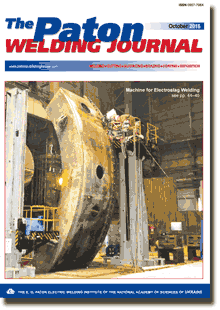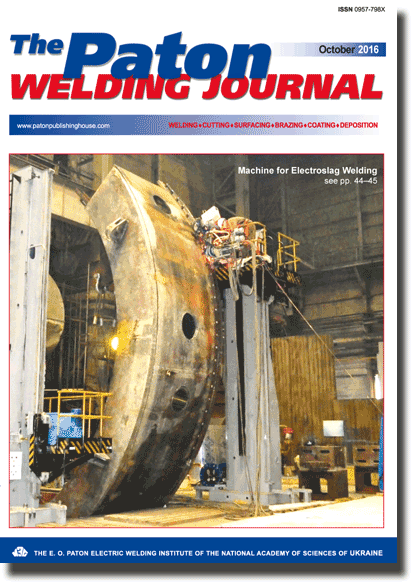| 2016 №10 (02) |
DOI of Article 10.15407/tpwj2016.10.03 |
2016 №10 (04) |

The Paton Welding Journal, 2016, #10, 14-19 pages
Prediction of limiting amplitudes of cycle stresses of welded joints with steady residual stresses
V.A. Degtyarev
G.S. Pisarenko Institute for Problems of Strength, NASU 2 Timiryazevskaya Str., 01014, Kiev, Ukraine. E-mail: ips@ipp.kiev.ua
Abstract
In the work the method for determination of diagrams of limiting amplitudes of the cycle of welded joints with steady residual tensile stresses is proposed based on the results of tests of small specimens, which can be considered as an express method for calculation of characteristics of fatigue resistance of welded joints when there is no possibility to carry out full-scale investigations and the appropriate computational dependences are presented. The analysis of literature data for different types of welded joints showed satisfactory correlation of experimental and calculated values of fatigue limits of welded joints of low-carbon and low-alloyed steels of a low strength. It was established that all the diagrams of limiting amplitudes of the cycle of welded joints with steady residual stresses are finished on the line, where each point at different mean stresses of the cycle corresponds to the minimum limiting amplitude of the cycle of welded joint with its value of limiting steady residual stress, which provides realization of limiting stresses of cycle. It was shown that if at the low values of steady residual stresses the relative reduction in fatigue limits of butt welded joints of steels of different strength is occurred almost for the same value, then with their increase, the reduction of fatigue limit of steel with higher mechanical characteristics is more significant. 23 Ref., 1 Table, 3 Figures.
Keywords: amplitude of cycle stresses, mean stress of cycle, yield strength, steady residual stress, fatigue limit, diagram of limiting amplitudes of cycle
Received: 10.05.16
Published: 23.10.16
References
- Duchinsky, B.N. (1956) Endurance of components of welded bridge structures in fluctuating and alternate stresses. In: Examination of strength of welded bridge structures. Issue 20. Moscow: Transzheldorizdat.
- Okerblom, N.O. (1950) Welding stresses in metal structures. Moscow; Leningrad: Mashgiz.
- Hobbacher, A. Recommendations on fatigue of welded components. IIW Doc. X-1539-94-XV-845–94.
- Trufyakov, V.I. (1973) Fatigue of welded joints. Kiev: Naukova Dumka.
- Bajkova, I.P. (1969) Influence of external tensile load on welded strains and stresses. Proizvodstvo, 6, 3–5.
- Ryakhin, V.A., Moshkarev, G.N. (1984) Service life and stability of welded structures of construction site and road making machines. Moscow: Mashinostroenie.
- Dawson, R. (1980) Vibration stress relieving and study of its efficiency. Teoreticheskie Osnovy, 102(2), 1–9.
- Trufyakov, V.I., Kudryavtsev, Yu.F., Mikheev, P.P. (1988) On effect of residual stresses on fatigue resistance of welded joints. Svarka, 2, 1–4.
- Shulginov, B.S., Degtyarev, V.A., Matveev, V.V. (1984) On limit cycle stresses of welded joints with high residual stresses. Problemy Prochnosti, 3, 58–61.
- Trufyakov, V.I., Mikheev, P.P., Kudryavtsev, Yu.F. (1988) Change of fatigue resistance of welded joints under action of residual stresses. In: of 3rd All-Union Symp. on Residual Technological Stresses (Kutaisi, October, 1988). Moscow: In-te for Problems in Mechanics, 358–364.
- Serensen, S.V., Kogaev, V.P., Shnejderovich, R.M. (1975) Load-carrying capacity and strength calculations of machine parts. Moscow: Mashinostroenie.
- Degtyarev, V.A., Shulginov, B.S. (2008) Assessment of limit cycle stresses for welded joints with high residual stresses by testing results of small-sized specimens without residual stresses. Problemy Prochnosti, 2, 66–81.
- Troshchenko, V.T., Tsybanev, G.V., Gryaznov, B.A. et al. (2009) Fatigue of metals. Influence of surface state and contact interaction. In: Strength of materials and structures, Vol. 2. Kiev: IPS.
- Degtyarev, V.A., Vlasenko, V.I. (1992) Application of complex diagram of limit cycle stresses for vibration treatment purpose. Tyazholoe Mashinostroenie, 8, 27–30.
- Navrotsky, D.I. (1961) Strength of welded joints. Moscow: Mashgiz.
- Trufyakov, V.I. (1956) About the role of residual stresses in reduction of endurance of welded joints. Svarka, 5, 90–103.
- Myunze, V.Kh. (1968) Fatigue strength of steel welded structures. Moscow: Mashinostroenie.
- Trufyakov, V.I., Gushcha, O.I., Trotsenko, V.P. (1976) Change of residual stresses in stress concentration zones at cyclic loading of welded joints. Problemy Prochnosti, 12, 14–17.
- (1991) Guidelines. Engineering safety. Probabilistic method of calculation of welded structures fatigue. Standard RD 50-694–90. Valid from 01.07.91. Moscow: Standart.
- Kudryavtsev, I.V., Naumchenkov, N.E. (1976) Fatigue of welded structures. Moscow: Mashgiz.
- Popova, M.M. (1978) Fatigue resistance of 14Kh2GMR steel welded joints. Metal structures of crane and examination of conveyors. LPI, 362, 70–74.
- Eregin, L.P., Naumchenkov, N.E. (1971) Static and fatigue strength of butt welded joints of 09G2S steel made on ground and roll scale. Proizvodstvo, 11, 36–39.
- Oding, I.L. (1962) Admissible stresses in machine-building and cyclic strength of metals. Moscow: Mashgiz.
Suggested Citation
V.A. Degtyarev (2016) Prediction of limiting amplitudes of cycle stresses of welded joints with steady residual stresses. The Paton Welding J., 10, 14-19.The cost of subscription/purchase order journals or individual articles
| Journal/Currency | Annual Set | 1 issue printed |
1 issue |
one article |
| TPWJ/USD | 384 $ | 32 $ | 26 $ | 13 $ |
| TPWJ/EUR | 348 € | 29 € | 24 € | 12 € |
| TPWJ/UAH | 7200 UAH | 600 UAH | 600 UAH | 280 UAH |
| AS/UAH | 1800 UAH | 300 UAH | 300 UAH | 150 UAH |
| AS/USD | 192 $ | 32 $ | 26 $ | 13 $ |
| AS/EUR | 180 € | 30 € | 25 € | 12 € |
| SEM/UAH | 1200 UAH | 300 UAH | 300 UAH | 150 UAH |
| SEM/USD | 128 $ | 32 $ | 26 $ | 13 $ |
| SEM/EUR | 120 € | 30 € | 25 € | 12 € |
| TDNK/UAH | 1200 UAH | 300 UAH | 300 UAH | 150 UAH |
| TDNK/USD | 128 $ | 32 $ | 26 $ | 13 $ |
| TDNK/EUR | 120 € | 30 € | 25 € | 15 € |
AS = «Automatic Welding» - 6 issues per year;
TPWJ = «PATON WELDING JOURNAL» - 12 issues per year;
SEM = «Electrometallurgy Today» - 4 issues per year;
TDNK = «Technical Diagnostics and Non-Destructive Testing» - 4 issues per year.


